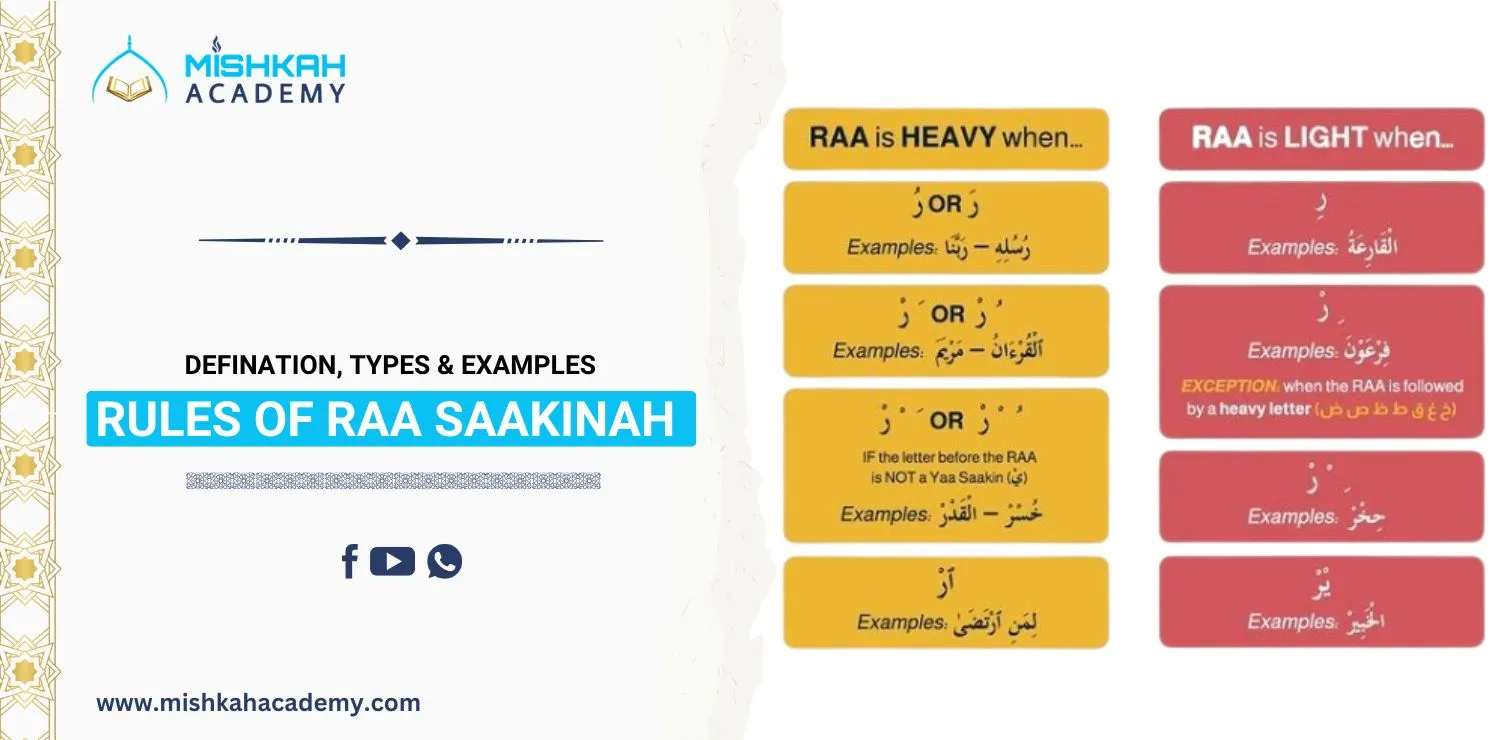Tajweed is necessary to the proper recitation of the Quran, which is an important part of adoration. The correct pronunciation of Raa Saakinah (رْ), which represents the letter ر when it lacks a vowel or is in a “still” state, is an important part of Tajweed. Heavy (tafkhim) or light (tarqeeq) pronunciations of ر depend on the surrounding vowels and the word’s position. The requirements for each pronunciation will be covered below, along with examples to help clarify each guideline.
Definition of Raa Saakinah
Table of Contents
ToggleRaa Saakinah is the letter ر pronounced without a vowel when it has a sukoon (ـْـ). The ر sound in Tajweed can be pronounced gently to produce a thin, soft sound (tarqeeq) or heavily to produce a full, deep sound (tafkhim).
Tarqeeq creates a softer, more delicate sound, whilst Tafkhim makes the ر sound heavier. The vowels that come before or after the Raa Saakinah, as well as its location inside the word, determine whether to use tafkhim and tarqeeq.
Types of Raa Saakinah Rules
There are three main scenarios to consider in pronouncing Raa Saakinah:
- Pronounce Raa Saakinah with Tafkhim (heavy sound)
- Pronounce Raa Saakinah with Tarqeeq (light sound)
- Situations where the rule is flexible, based on context
Let’s explore these scenarios with rules and examples with Mishkah Academy.
When a Fathah or Dhammah comes before Raa Saakinah:
a) Tafkhim (Heavy Sound)
Raa Saakinah should be pronounced with tafkhim (heavy sound) in the following cases:
1: The letter ر is pronounced heavily if it is saakin (has no vowel) and comes before a Fathah (ـَـ) or a Dhammah (ـُـ).
Examples:
- مَرْحَمَةٍ (marḥamah): Here, the ر follows a Fathah, so it’s pronounced with tafkhim.
- قُرْآنٌ (qur’ān): The ر follows a Dhammah, making it heavy.
2: When Raa Saakinah is preceded by a sukoon, and that sukoon is preceded by a Fathah:
If ر is saakin and there is a sukoon before it, which is then preceded by a Fathah, it should also be pronounced with tafkhim.
Example:
- الْقَرْيَةِ (al-qaryah): Here, ر is saakin, preceded by a sukoon (قَـ), which in turn follows a Fathah. Therefore, ر is pronounced heavily.
3: When the Raa is in the Muqatta’at letters (like in Surah Yusuf or Surah Ar-Ra’d):
Because of its position and recitation manner in these conditions, ر is usually pronounced with tafkhim in certain isolated letters at the start of chapters, such المر (Alif Laam Meem Raa).
For instance, الر (Alif Laam Raa), which is repeated with tafkhim at the start of Surah Ar-Ra’d.
Note: Enroll in the Advance Tajweed course to learn Rules of Raa Saakinah with expert Egyptian Tajweed tutors.
Start Your Tajweed Learning Journey Today
b) Tarqeeq (Light Sound)
Raa Saakinah is pronounced with tarqeeq (light sound) in the following cases:
1:When Raa Saakinah is preceded by a Kasrah:
If the ر is saakin and is preceded by a Kasrah (ـِـ), it should be pronounced with a light sound.
Examples:
- فِرْعَوْنَ (Fir’awn): The ر follows a Kasrah, so it is pronounced lightly.
- مِرْيَةٍ (Miryah): The ر follows a Kasrah here as well, making it light.
2: In cases when Yaa Saakinah comes before Raa Saakinah:
It should be pronounced lightly if ر comes after a Yaa with a sukoon (ـِيـْـ).
For instance, خَيْرٍ (khayr): The ر is pronounced with tarqeeq (light sound) since it comes after a quiet Yaa.
C) Situational Flexibility (Waqf and Specific Circumstances)
Depending on the verse’s context or particular recitation conditions, the pronunciation of ر may at times change. These consist of:
1: Stopping (Waqf) on Words Ending with Raa Saakinah:
The pronunciation may change depending on the preceding vowel when stopping (waqf) on a word that ends in ر with a sukoon. α is often spoken gently if the preceding vowel is a Kasrah, but it may be pronounced with tafkheem if it is a Fathah or Dhammah.
Example:
- سِحْرٌ (siḥr): If stopping on this word, ر is generally pronounced with a light sound due to the preceding Kasrah.
- وَفُرَاتٌ (wa furaat): If stopping on فُرَات, ر is pronounced with a heavy sound due to the preceding Dhammah.
2: Dual-Meaning and Intonation Choices:
Depending on their meaning or recitation style, some words can have multiple-second pronunciations. For example, الْقِرَاءَة (recitation) may differ in several styles, but in general, the ر stays light and follows a Kasrah. However, a more emphatic pronunciation may be used in specific poetic or stressed recitation situations.
3: Summary of Raa Saakinah Rules
To compile the regulations:
- Use tafkhim When ر appears in the Muqatta’at letters or after a Fathah or Dhammah, use tafkhim (heavy sound).
- Use tarqeeq When ر comes after a Yaa Saakinah or a Kasrah, use tarqeeq, which is a light sound.
- Waqf flexibility: When pronouncing words that finish in ر, apply the previous vowel (Kasrah for light, Fathah/Dhammah for heavy).
Practical Tips to Learn Rules of Raa Saakinah in Tajweed
To ensure that tafkhim and tarqeeq are applied correctly, pay attention to expert Quranic reciters and try to emulate their pronunciation.
- Use Particular Examples to Practice: To improve your knowledge, find instances of Raa Saakinah in the Quran and use these guidelines.
- Ask for Advice: To guarantee proper application and steer clear of typical mistakes, practice with a certified Tajweed instructor.
Accurate Tajweed requires that Raa Saakinah be pronounced correctly, which also highlights the Quran’s depth and beauty. You will respect the purity of the Quran’s message and become more confident in your recitation if you follow to tajweed rules and guidelines. So must join online tajweed classes with Arab tutors at Mishkah Academy.






